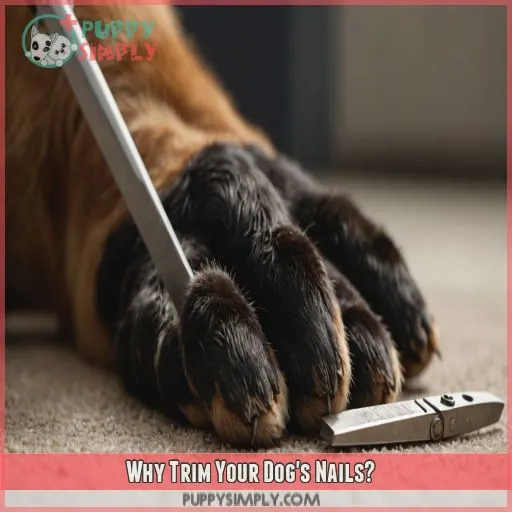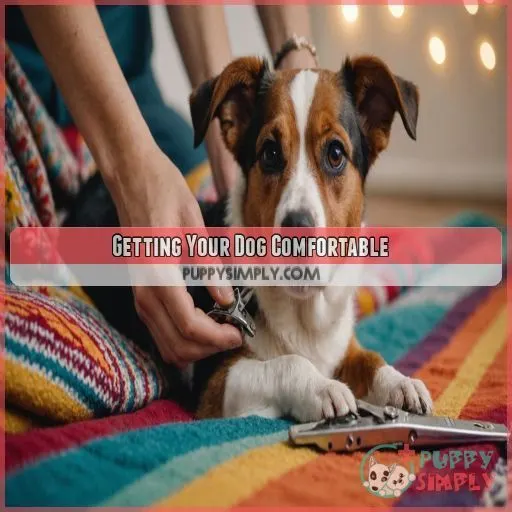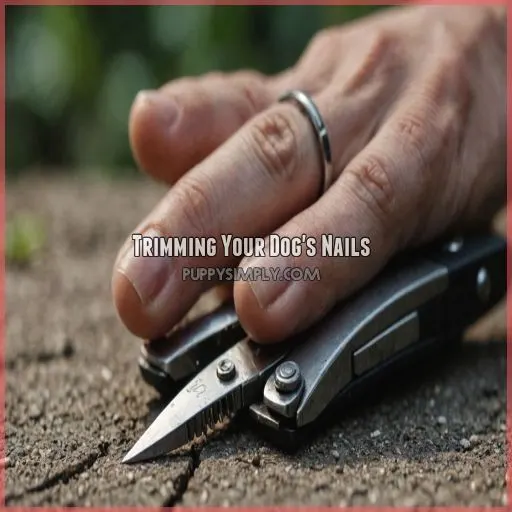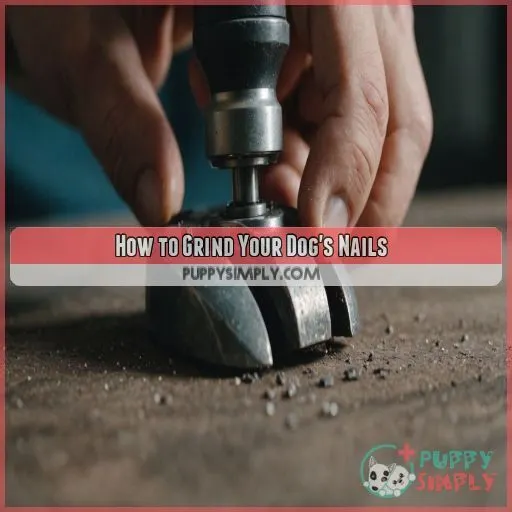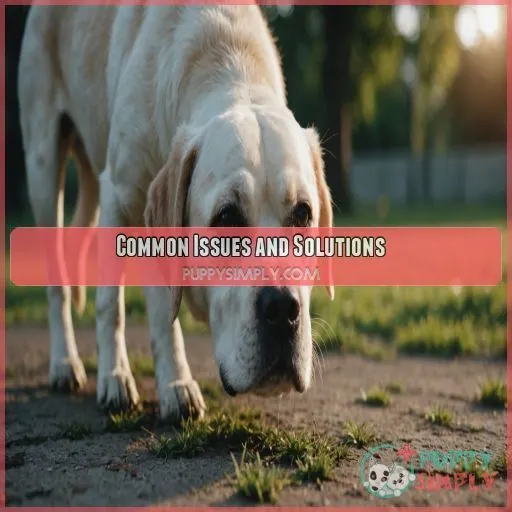This site is supported by our readers. We may earn a commission, at no cost to you, if you purchase through links.
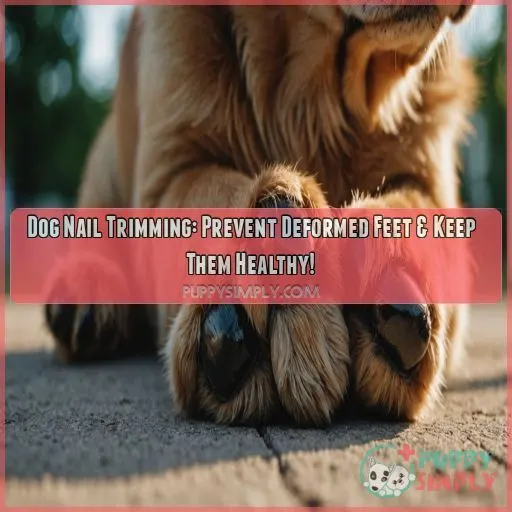
Imagine feeling like you’re walking in platforms all day – pretty awkward, right?
Long nails can cause your dog’s feet to splay, creating discomfort and altering their walking pattern.
This can lead to long-term joint issues or painful nails.
Trim those claws regularly to keep your furry friend’s feet healthy and their gait natural.
You’ll prevent infections and accidental scratches on you and your furniture, too!
Curious about the best techniques and tips for a smooth nail-trimming session?
Uncover more secrets to paw-sitive nail health.
Table Of Contents
- Key Takeaways
- Why Trim Your Dog’s Nails
- Getting Your Dog Comfortable
- Trimming Your Dog’s Nails
- How to Grind Your Dog’s Nails
- Common Issues and Solutions
- Maintaining Your Dog’s Nail Health
- Frequently Asked Questions (FAQs)
- How do I stop my dogs paw from bleeding after cutting his nails?
- What to do when dogs nail curled into paw?
- How do I secure my dog’s nail trim?
- What to give a dog to calm down to cut nails?
- What are the signs of overgrown nails in dogs?
- How do I determine the ideal nail length for my dog?
- Can I use human nail clippers on my dogs nails?
- How do I properly dispose of trimmed dog nails?
- What are the risks of not trimming my dogs nails?
- Conclusion
Key Takeaways
- Keeping your dog’s nails short isn’t just about fashion – it’s crucial for preventing those awkward, splayed feet that can lead to uncomfortable walks or joint issues. It’s like giving your pup a winning stride in the paw Olympics!
- Trimming those claws regularly keeps infections and painful ingrown nails at bay, ensuring happy and healthy paws. No one wants to deal with a puppy pedicure emergency!
- Introduce nail care as a fun bonding activity from day one. Massage their paws, let them sniff the clippers – make it a comforting ritual that feels more like playtime than a wrestling match.
- Who knew you’d become a nail-whispering guru? Remember, patience and treats can work wonders when easing your pup into nail trimming, transforming a potential drama into a peaceful spa day.
Why Trim Your Dog’s Nails
You might think of nail care as a spa service for your dog, but it’s more like keeping their "spring-loaded paws" in check for health and safety. Cutting your dog’s nails isn’t just avoiding scratches; it’s about preventing painful foot deformities and ensuring their feet stay healthy and happy.
Preventing Deformed Feet
Want to avoid a splayed foot and promote healthy nail growth patterns? Dog nail trimming prevents deformed feet—here’s how:
- Protect footpad health.
- Promote proper puppy nail care.
- Watch for overgrown nails.
- Trim dewclaws regularly.
Reducing Strain on Joints
Long dog nails mightn’t seem like a big deal, but they actually affect joint health a lot. Overgrown nails can pressure paws, altering mobility. Trimming encourages healthy posture, reducing potential joint pain and ensuring comfortable steps.
Preventing Infection and Pain
Overgrown nails can lead to painful infections and ingrown nails. Trim regularly to prevent issues like:
- Nail bleeding
- Quick cutting
- Infection
- Pain
Keeping your pup’s feet healthy and happy is key!
Keeping Your Dog’s Feet Healthy
Now that you’ve tackled infection, let’s wag over to keeping your dog’s feet fit as a fiddle. Healthy nails mean happy paws, preventing future dog paw problems.
| Dog Foot Care | Emotional Reward |
|---|---|
| Healthy paws | Unhindered play |
| Safe walks | Greater comfort |
| Happy tails | Joyful jumps |
| Strong nails | Confident strides |
Avoiding Accidental Scratching
Dog nail trimming is a key part of keeping your dog safe and happy, preventing deformed feet. Keeping nails short protects your furniture and makes playtime safe for everyone. Your kids’ safety depends on regular trims!
Getting Your Dog Comfortable
Getting your dog comfortable with nail trimming is really important to prevent future struggles and visits to the vet and avoid tendon injuries. By introducing clippers and praising good behavior, you can turn grooming time into a bonding moment rather than a wrestling match.
Handling Your Puppy’s Feet
Start handling your puppy’s feet from day one – it’s the key to comfortable nail trims! Massage their paws, touch their nails, and get them used to foot handling. This early socialization pays off big time.
- Puppy paw handling
- Early socialization
- Foot massage
- Nail growth awareness
Introducing Nail Clippers and Grinders
First introductions matter! Start by letting your puppy sniff the dog-friendly tools. Choose between dog nail clippers or a dog nail grinder.
| Clippers | Grinders |
|---|---|
| Easy for beginners | Ideal for thick nails |
| Less vibration | Gentle but noisy |
| May crush nail | Can overheat |
| Portable | Requires batteries |
| Quick and simple | Gradual and precise |
Gradually Desensitizing Your Dog
Desensitizing your dog to nail trimming takes patience and a slow introduction. Early socialization is key, so start while they’re a puppy! Gradually touch their paws with clippers, turning this new experience into a gentle, dog grooming journey. Be consistent, but relax—Rome wasn’t built in a day!
Rewarding Good Behavior
Positive reinforcement works wonders when trimming your dog’s nails. Think of treat rewards as your secret weapon. Praise methods like clicker training create a consistent routine. Trimming benefits everyone: risk reduction, comfort, and healthy paws. Make it fun—you’re the nail whisperer!
Trimming Your Dog’s Nails
Trimming your dog’s nails is essential for their comfort and foot health. With the right tools and techniques, you can easily trim your pup’s nails and prevent painful deformities.
Choosing the Right Clippers
Choosing the right clippers for dog nail trimming is important choosing the right clippers. Consider:
- Clipper types: Guillotine or scissor.
- Size matters: Fit your dog’s nails.
- Blade sharpness for a clean cut.
- Safety features prevent injuries.
Holding Your Dog’s Paw Correctly
To nail dog nail trimming, find your thumb’s sweet spot on the pad and the forefinger above the nail and learn the importance of regular nail maintenance. Apply gentle paw pressure ensuring your dog’s comfort. Avoid dog nail trimming mistakes with a secure grip.
Trimming the Quick Safely
When trimming your dog’s nails, spot the quick—a mildly sneaky pink or gray area—to avoid pain and bleeding. Use sharp clippers, trim slowly, and keep nail length manageable to prevent deformed feet and promote comfort.
Filing the Nails After Clipping
After clipping your dog’s nails, use a file to smooth rough edges and prevent snagging. Gently file across the bottom and tip of each nail for a clean, comfortable finish.
Using Styptic Powder to Stop Bleeding
After filing, keep styptic powder close—everyone makes mistakes and it’s nothing but a hiccup. Control quick bleeding with these steps:
- Apply styptic powder or alternatives.
- Press gently.
- Comfort your pup—you’re a nail-trimming superhero!
How to Grind Your Dog’s Nails
Grinding your dog’s nails can be a bit like giving them a mini pedicure—minus the cucumber water! By choosing the right grinder and working slowly, you can keep your dog’s feet looking great while avoiding discomfort and maintaining their nail health.
Choosing the Right Grinder
When choosing a grinder for dog nail trimming, look for variable speed and low noise levels to keep your pooch comfortable. Regular maintenance keeps the grinder safe and effective, just like a trusty Swiss army knife.
Supporting the Dog’s Toe
When grinding your dog’s nails, gently yet firmly support their toe, positioning your thumb on the pad and forefinger above the nail for a comfortable, secure grip.
Grinding Across the Bottom of the Nail
When grinding your dog’s nails, carefully work across the bottom. Choose wisely between nail grinder types, remembering frequency matters:
- Grinding vs. clipping
- Grinding techniques
- Nail grinding safety
- Debunking dog nail trimming myths
Really, it’s a breeze!
Smoothing Rough Edges
Imagine this: after a trim, use a grinder to smooth rough edges. Its like giving your dog a pedicure. Proper nail smoothness enhances comfort and prevents snagging. Ignore nail trimming myths; your pups paws deserve it!
Keeping Your Dog Comfortable
Keep your pup chill during nail trims with calming techniques. Try a gentle paw massage to ease dog anxiety. Debunk dog nail trimming myths—the process needn’t harm. Tackle nail sensitivity by creating a relaxing ambiance.
Common Issues and Solutions
Dealing with a bleeding nail or an ingrown toenail can be tricky, but don’t worry – we’ve got you covered. From calming your anxious pup to securing a successful nail trim, this section will walk you through common issues and practical solutions.
What to Do When a Dog’s Nail Bleeds
Did you accidentally clip too far and cause nail bleeding? Stay calm. Quickly grab styptic powder; it’s like magic dust for bleeding control. A little pressure should stop the bleeding. Remember, dog nail care isn’t all myths and exaggerations—accidents can happen!
How to Handle a Curled or Ingrown Nail
If your dog’s nail bleeds, don’t fret; accidents happen. Now, let’s tackle curled or ingrown nails. These occur when nails grow too long or incorrectly. Trim regularly and maintain a healthy nail length to prevent discomfort. Your dog will thank you!
Securing Your Dog’s Nail Trim
Got a wiggly pup during nail trims? You’re not alone! Secure your grip by holding your dog’s paw gently yet firmly. Use tools like clippers with safety guards to avoid mishaps. Remember, trimming isn’t rocket science—just be patient, and you’ll succeed!
Calming Your Dog During Nail Trimming
Feeling anxious? Your pup picks up on that. Stay calm and use positive reinforcement like treats and praise. Distract them with peanut butter or gentle handling. With patience, you can make nail trims a breeze for both of you.
Maintaining Your Dog’s Nail Health
Keeping your dog’s nails in tip-top shape isn’t just about aesthetics, it’s about ensuring their paws stay healthy and infection-free. Regular trims, vigilant checks for any signs of trouble, and washing those little toes will keep your pup prancing happily like the canine superstar they are!
Regular Trimming and Filing
After tackling common trimming issues, focus on regular trimming and filing. Don’t let your dog’s nails grow like vines!
- Set a trimming schedule
- Use proper nail filing tools
- Include dewclaw trimming
- Master trimming techniques
- Decide: home nail trimming vs. groomer
Monitoring for Signs of Infection
Keep an eagle eye on your dog’s nails for signs of trouble, such as redness, swelling, or discharge. If Fido’s limping or obsessively licking his paws, it might be time for a vet visit. Catching issues early will save headaches later!
Adjusting Your Trimming Technique
If your dog’s nails aren’t shortening as expected, try adjusting your trimming technique. Clip at a slightly steeper angle, and pay close attention to the quick’s location. With some tweaks, you’ll have your pup’s nails in tip-top shape.
Keeping Your Dog’s Feet Clean and Dry
You’ve mastered trimming, but don’t let wet paws pull the rug from under you! Keep your dog’s feet clean and dry with a paw cleaning routine. Wet paw protection prevents foot health issues, keeping those toes feeling tip-top and trouble-free.
Frequently Asked Questions (FAQs)
How do I stop my dogs paw from bleeding after cutting his nails?
Oops, you’ve nicked the quick! Think "magic dust." Grab styptic powder or cornstarch, dab it on the bleeding nail, and apply gentle pressure. This wizardry swiftly stops bleeding, ensuring your furry friend stays comfy and safe.
What to do when dogs nail curled into paw?
When your dog’s nail curls into the paw, it’s time to call the vet—it’s like the claw’s gone rogue. They’ll trim it safely, preventing pain and infection. Give your pup some TLC and treats afterward!
How do I secure my dog’s nail trim?
To secure your dog’s nail trim, start young, offer treats as incentives, and approach the process like a dance—gentle and with rhythm. Keep styptic powder handy just in case, and always use dog-friendly clippers!
What to give a dog to calm down to cut nails?
Imagine Emma’s pug, Baxter, calming down like he’s at a spa. Try offering a calming chew specially made for dogs, or simply using natural treats with a soothing scent. Keep it chill and nail that trim!
What are the signs of overgrown nails in dogs?
You know your dog’s nails are overgrown when you hear constant tapping on hard floors. Watch out for curved nails that touch the ground. These brown ticking time-bombs can cause discomfort, mobility issues, or deformities if not trimmed.
How do I determine the ideal nail length for my dog?
Think of your dog’s nails as high heels—fabulous but painful when too long! Aim for nails just shy of the floor when standing. If you hear clicking, it’s time to clip! Keep it gentle and positive.
Can I use human nail clippers on my dogs nails?
Don’t use human nail clippers on a dog—they’re not strong enough and can crush the nail. Invest in dog-specific clippers. They’ll trim more effectively and help keep your furry friend‘s paws healthy and happy in the long run.
How do I properly dispose of trimmed dog nails?
When life gives you trimmed dog nails, toss them in the trash. Don’t let these little crescents clutter your space—secure them in a sealed bag to prevent odors and surprises. It’s simple as pie for a clean home!
What are the risks of not trimming my dogs nails?
Leaving your dog’s nails untrimmed is like wearing shoes two sizes too small. It causes discomfort, potential infection, and strains their joints, leading to pain. Regular trimming keeps your four-legged friend comfy, preventing life’s little "missteps.
Conclusion
Ultimately, keeping your dog’s nails trimmed is a small but important step in maintaining their paw-fect health overgrown nail dangers. By preventing deformed feet and joint issues, you’ll help your canine companion move through life with ease. So don’t delay – grab those dog nail clippers and get to work! Your furry friend will thank you for prioritizing their paw-sitive nail health.

